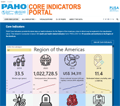
French Guyana - Profile
The Health in the Americas+ country profiles are based on the interagency indicators available as of the dates referenced. The sources are referenced in this table. In some cases, the values of the indicators may differ from the most recent data available in the country.
Environmental and social determinants of health
In 2000 the total population of French Guiana was 160 620 inhabitants; by 2024 this figure had risen to 308 522, representing a 92.1% increase. Regarding the country’s demographic profile, in 2024 people over 65 years of age accounted for 7.% of the total population, an increase of 3.3 percentage points compared to the year 2000. In 2024, there were 107.8 women per 100 men and 22.6 older people (65 years or older) per 100 children under 15 years of age, as can be seen in the country’s population pyramids, distributed by age group and sex (Figure 1). Considering the population between 15 and 64 years of age to be potentially active (i.e., potential participants in the labor force), this group represented 61.9% of the total population of the country in 2024 ( 190 883 people). When we add these figures to the potentially passive population ( 95 935 under 15 years of age and 21 706 over 65 years of age), the result is a dependency ratio of 61.6 potentially passive people per 100 potentially active people. This ratio was 64.0 in 2000.
Life expectancy at birth in 2024 was 77.2 years, lower than the average for the Region of the Americas and 4.2 years higher that in 2000 (73).
Figure 1. Population pyramids, years 2000 and 2024
Health situation
Maternal and child health
Between 2000 and 2020, infant mortality in French Guiana decreased from 12.4 to 8.2 deaths per 1000 live births, a decrease of 33.9% (Figure 4). The percentage of low-weight births (less than 2500 g) increased from 11.1% to 13.0% between 2003 and 2016.
In relation to fertility, it is estimated that in 2023 women had an average of 3.4 children throughout their reproductive lives. In relation to fertility, it is estimated that in 2024 women had an average of 3.3 children throughout their reproductive lives. In the specific case of adolescent fertility, there was a 54.3% decrease, from 114.3 live births per 1000 women aged 15 to 19 years in 2000 to 52.3 in 2024. In 2010, 99.0% of births were attended by skilled birth personnel. In the period between 2009 and 2016, there was an increase in prenatal care, which went from 55.2% to 84.5%.
Communicable diseases
In 2014, the estimated human immunodeficiency virus (HIV) infection incidence rate (new diagnoses) was 75.6 per 100 000 population.
Status of the COVID-19 Pandemic
During 2020, there were a total of 13 166 cases of COVID-19 in French Guiana, representing 44,232 per million population. In 2021, the number of identified cases amounted to 38 771, equivalent to 120,175 per million inhabitants, while in 2022, the number of reported cases was 44 988, equivalent to 151,140 cases per million inhabitants. With regard to deaths directly caused by COVID-19, in 2020, 71 deaths of persons diagnosed with COVID-19 were reported corresponding to a rate of death per million population of 239, while in 2021, 339 were reported, representing 900 deaths per million inhabitants, in 2022 were reported 410 deaths, equivalent to 239 deaths per million inhabitants. In the Region of the Americas, French Guiana ranked 23th in the number of deaths due to COVID-19 in 2020, moved to position 26th in 2021 and in 2022 ranked 36th, with a cumulative figure for the years of 1,377 deaths per million population (Figure 2).
By December 31, 2021, 32.6% of the country's population had at least one dose of COVID-19 vaccine. By April 20, 2022 (latest available data), 30% of the population was fully vaccinated. The vaccination campaign started on January 20, 2021 and so far, 2 types of COVID-19 vaccines have been used in the country.
Figure 2. Cumulative COVID-19 deaths in the Region of the Americas, to July 29th, 2023
The sources of the interagency indicators used in this profile can be found in this table.
 For the latest data on health indicators for the Region of the Americas, be sure to visit the PAHO Core Indicators portal.
For the latest data on health indicators for the Region of the Americas, be sure to visit the PAHO Core Indicators portal.
COUNTRY/TERRITORY PROFILES
Anguilla
Antigua and Barbuda
Argentina
Aruba
Bahamas
Barbados
Belize
Bermuda
Bolivia
Bonaire, Sint Eustatius, and Saba
Brazil (English) (Português)
Canada
Cayman Islands
Chile
Colombia
Costa Rica
Cuba
Curaçao
Dominica
Dominican Republic
Ecuador
El Salvador
French Guiana, Guadeloupe and Martinique
Grenada
Guatemala
Guyana
Haiti (English) (Français)
Honduras
Jamaica
Mexico
Montserrat
Nicaragua
Panama
Paraguay
Peru
Puerto Rico
Saint Kitts and Nevis
Saint Lucia
Saint Vincent and the Grenadines
Sint Maarten
Suriname
Trinidad and Tobago
Turks and Caicos Islands
United States of America
Uruguay
Venezuela
Virgin Islands (British)
Virgin Islands (U.S.)


